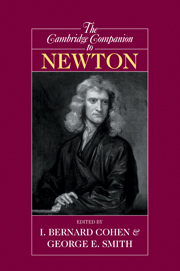Book contents
- Frontmatter
- Introduction
- 1 Newton's philosophical analysis of space and time
- 2 Newton's concepts of force and mass, with notes on the Laws of Motion
- 3 Curvature in Newton's dynamics
- 4 The methodology of the Principia
- 5 Newton's argument for universal gravitation
- 6 Newton and celestial mechanics
- 7 Newton's optics and atomism
- 8 Newton's metaphysics
- 9 Analysis and synthesis in Newton's mathematical work
- 10 Newton, active powers, and the mechanical philosophy
- 11 The background to Newton's chymistry
- 12 Newton's alchemy
- 13 Newton on prophecy and the Apocalypse
- 14 Newton and eighteenth-century Christianity
- 15 Newton versus Leibniz: from geometry to metaphysics
- 16 Newton and the Leibniz-Clarke correspondence
- Bibliography
- Index
2 - Newton's concepts of force and mass, with notes on the Laws of Motion
Published online by Cambridge University Press: 28 May 2006
- Frontmatter
- Introduction
- 1 Newton's philosophical analysis of space and time
- 2 Newton's concepts of force and mass, with notes on the Laws of Motion
- 3 Curvature in Newton's dynamics
- 4 The methodology of the Principia
- 5 Newton's argument for universal gravitation
- 6 Newton and celestial mechanics
- 7 Newton's optics and atomism
- 8 Newton's metaphysics
- 9 Analysis and synthesis in Newton's mathematical work
- 10 Newton, active powers, and the mechanical philosophy
- 11 The background to Newton's chymistry
- 12 Newton's alchemy
- 13 Newton on prophecy and the Apocalypse
- 14 Newton and eighteenth-century Christianity
- 15 Newton versus Leibniz: from geometry to metaphysics
- 16 Newton and the Leibniz-Clarke correspondence
- Bibliography
- Index
Summary
VARIETIES OF FORCE IN THE PRINCIPIA
Newton's physics is based on two fundamental concepts: mass and force. In the Principia Newton explores the properties of several types of force. The most important of these are the forces that produce accelerations or changes in the state of motion or of rest in bodies. In Definition 4 of the Principia, Newton separates these into three principal categories: impact or percussion, pressure, and centripetal force. In the Principia, Newton mentions other types of forces, including (in Book 2) the forces with which fluids resist motions through them. Of a different sort is Newton's “force of inertia,” which is neither an accelerative force nor a static force and is not, properly speaking in the context of dynamics, a force at all.
The structure of Newton’s Principia follows a classical pattern: definitions and axioms, followed by the statement of propositions and their demonstrations. Newton’s treatise differs, however, from classical (or Greek) geometry in two respects. First, there is a constant appeal to the method of limits – Newton’s “first and ultimate ratios,” as set forth in Book 1, Section 1. Second, the validity of propositions is tied to evidence of experiment and critical observation.
In the demonstrations in the Principia, Newton generally proceeds by establishing a series of proportions from a geometric configuration. He then allows one or more of the parameters to be diminished without limit, thereby obtaining a limiting (“ultimate”) value of the geometric ratio. It is in the limit that Newton’s proofs are valid.
- Type
- Chapter
- Information
- The Cambridge Companion to Newton , pp. 57 - 84Publisher: Cambridge University PressPrint publication year: 2002
- 9
- Cited by



